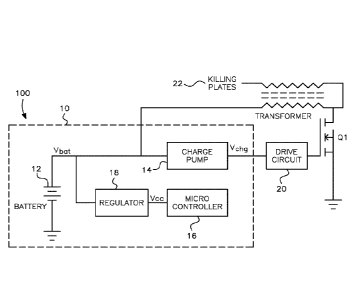Une partie des informations de ce site Web a été fournie par des sources externes. Le gouvernement du Canada n'assume aucune responsabilité concernant la précision, l'actualité ou la fiabilité des informations fournies par les sources externes. Les utilisateurs qui désirent employer cette information devraient consulter directement la source des informations. Le contenu fourni par les sources externes n'est pas assujetti aux exigences sur les langues officielles, la protection des renseignements personnels et l'accessibilité.
L'apparition de différences dans le texte et l'image des Revendications et de l'Abrégé dépend du moment auquel le document est publié. Les textes des Revendications et de l'Abrégé sont affichés :
| (12) Brevet: | (11) CA 3087054 |
|---|---|
| (54) Titre français: | PIEGE A RONGEURS ELECTRONIQUE AVEC CIRCUIT SURVOLTEUR POUR DES PERFORMANCES DE PIEGE AMELIOREES PENDANT LA DUREE DE VIE DE LA BATTERIE |
| (54) Titre anglais: | ELECTRONIC RODENT TRAP WITH VOLTAGE BOOSTER CIRCUIT FOR IMPROVED TRAP PERFORMANCE OVER THE LIFE OF THE BATTERY |
| Statut: | Octroyé |
| (51) Classification internationale des brevets (CIB): |
|
|---|---|
| (72) Inventeurs : |
|
| (73) Titulaires : |
|
| (71) Demandeurs : |
|
| (74) Agent: | PIASETZKI NENNIGER KVAS LLP |
| (74) Co-agent: | |
| (45) Délivré: | 2024-03-19 |
| (86) Date de dépôt PCT: | 2018-12-18 |
| (87) Mise à la disponibilité du public: | 2019-07-04 |
| Requête d'examen: | 2021-10-28 |
| Licence disponible: | S.O. |
| (25) Langue des documents déposés: | Anglais |
| Traité de coopération en matière de brevets (PCT): | Oui |
|---|---|
| (86) Numéro de la demande PCT: | PCT/US2018/066261 |
| (87) Numéro de publication internationale PCT: | WO2019/133340 |
| (85) Entrée nationale: | 2020-06-25 |
| (30) Données de priorité de la demande: | ||||||
|---|---|---|---|---|---|---|
|
L'invention concerne un circuit et un procédé pour amplifier l'entrée de tension à la grille d'un commutateur MOSFET utilisé dans un piège à rongeur électronique. En amplifiant la tension à la grille, le MOSFET peut être complètement mis en marche pour activer un cycle de mise à mort efficace dans le piège à rongeur électronique même lorsque la tension de la batterie du piège a chuté à un niveau qui serait sinon insuffisant pour activer complètement le MOSFET.
A circuit and method for boosting the voltage input to the gate of a MOSFET switch used in an electronic rodent trap is provided. By boosting the voltage to the gate, the MOSFET can be fully turned on to activate an effective killing cycle in the electronic rodent trap even when the trap's battery voltage has dropped to a level that would otherwise be insufficient to fully activate the MOSFET.
Note : Les revendications sont présentées dans la langue officielle dans laquelle elles ont été soumises.
Note : Les descriptions sont présentées dans la langue officielle dans laquelle elles ont été soumises.

Pour une meilleure compréhension de l'état de la demande ou brevet qui figure sur cette page, la rubrique Mise en garde , et les descriptions de Brevet , États administratifs , Taxes périodiques et Historique des paiements devraient être consultées.
| Titre | Date |
|---|---|
| Date de délivrance prévu | 2024-03-19 |
| (86) Date de dépôt PCT | 2018-12-18 |
| (87) Date de publication PCT | 2019-07-04 |
| (85) Entrée nationale | 2020-06-25 |
| Requête d'examen | 2021-10-28 |
| (45) Délivré | 2024-03-19 |
Il n'y a pas d'historique d'abandonnement
Dernier paiement au montant de 210,51 $ a été reçu le 2023-11-22
Montants des taxes pour le maintien en état à venir
| Description | Date | Montant |
|---|---|---|
| Prochain paiement si taxe applicable aux petites entités | 2024-12-18 | 100,00 $ |
| Prochain paiement si taxe générale | 2024-12-18 | 277,00 $ |
Avis : Si le paiement en totalité n'a pas été reçu au plus tard à la date indiquée, une taxe supplémentaire peut être imposée, soit une des taxes suivantes :
Les taxes sur les brevets sont ajustées au 1er janvier de chaque année. Les montants ci-dessus sont les montants actuels s'ils sont reçus au plus tard le 31 décembre de l'année en cours.
Veuillez vous référer à la page web des
taxes sur les brevets
de l'OPIC pour voir tous les montants actuels des taxes.
| Type de taxes | Anniversaire | Échéance | Montant payé | Date payée |
|---|---|---|---|---|
| Enregistrement de documents | 2020-06-25 | 100,00 $ | 2020-06-25 | |
| Le dépôt d'une demande de brevet | 2020-06-25 | 400,00 $ | 2020-06-25 | |
| Taxe de maintien en état - Demande - nouvelle loi | 2 | 2020-12-18 | 100,00 $ | 2020-12-02 |
| Taxe de maintien en état - Demande - nouvelle loi | 3 | 2021-12-20 | 100,00 $ | 2021-10-28 |
| Requête d'examen | 2023-12-18 | 816,00 $ | 2021-10-28 | |
| Taxe de maintien en état - Demande - nouvelle loi | 4 | 2022-12-19 | 100,00 $ | 2022-11-22 |
| Taxe de maintien en état - Demande - nouvelle loi | 5 | 2023-12-18 | 210,51 $ | 2023-11-22 |
| Taxe finale | 416,00 $ | 2024-02-06 |
Les titulaires actuels et antérieures au dossier sont affichés en ordre alphabétique.
| Titulaires actuels au dossier |
|---|
| WOODSTREAM CORPORATION |
| Titulaires antérieures au dossier |
|---|
| S.O. |